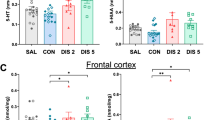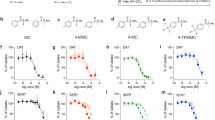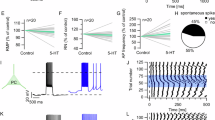Abstract
The striatum is richly innervated by serotonergic afferents from the raphe nucleus. We explored the effects of this input on striatal cholinergic interneurons from rat brain slices, by means of both conventional intracellular and whole-cell patch-clamp recordings. Bath-applied serotonin (5-HT, 3–300 μM), induced a dose-dependent membrane depolarization and increased the rate of spiking. This effect was mimicked by the 5-HT reuptake blockers citalopram and fluvoxamine. In voltage-clamped neurons, 5-HT induced an inward current, whose reversal potential was close to the K+ equilibrium potential. Accordingly, the involvement of K+ channels was confirmed either by increasing extracellular K+ concentration and by blockade of K+ channels with barium. Single-cell reverse transcriptase-polymerase chain reaction (RT-PCR) profiling demonstrated the presence of 5-HT2C, 5-HT6, and 5-HT7 receptor mRNAs in identified cholinergic interneurons. The depolarization/inward current induced by 5-HT was partially mimicked by the 5-HT2 receptor agonist 2,5-dimethoxy-4-iodoamphetamine and antagonized by both ketanserin and the selective 5-HT2C antagonist RS102221, whereas the selective 5-HT3 and 5-HT4 receptor antagonists tropisetron and RS23597-190 had no effect. The depolarizing response to 5-HT was also reduced by the selective 5-HT6 and 5-HT7 receptor antagonists SB258585 and SB269970, respectively, and mimicked by the 5-HT7 agonist, 5-CT. Accordingly, activation of either 5-HT6 or 5-HT7 receptor induced an inward current. The 5-HT response was attenuated by U73122, blocker of phospholipase C, and by SQ22,536, an inhibitor of adenylyl cyclase. These results suggest that 5-HT released by serotonergic fibers originating in the raphe nuclei has a potent excitatory effect on striatal cholinergic interneurons.
Similar content being viewed by others
Log in or create a free account to read this content
Gain free access to this article, as well as selected content from this journal and more on nature.com
or
Accession codes
References
Albin RL, Cross D, Cornblath WT, Wald JA, Wernette K, Frey KA et al (2003). Diminished striatal [123I]iodobenzovesamicol binding in idiopathic cervical dystonia. Ann Neurol 53: 528–532.
Aosaki T, Kiuchi K, Kawaguchi Y (1998). Dopamine D1-like receptor activation excites rat striatal large aspiny neurons in vitro. J Neurosci 18: 5180–5190.
Bayliss DA, Li YW, Talley EM (1997). Effects of serotonin on caudal raphe neurons: inhibition of N- and P/Q-type calcium channels and the afterhyperpolarization. J Neurophysiol 77: 1362–1374.
Bennett BD, Callaway JC, Wilson CJ (2000). Intrinsic membrane properties underlying spontaneous tonic firing in neostriatal cholinergic interneurons. J Neurosci 20: 8493–8503.
Bennett BD, Wilson CJ (1999). Spontaneous activity of neostriatal cholinergic interneurons in vitro. J Neurosci 19: 5586–5596.
Bianchi C, Siniscalchi A, Beani L (1989). Effect of 5-hydroxytryptamine on [3H]-acetylcholine release from guinea-pig striatal slices. Br J Pharmacol 97: 213–221.
Blandina P, Goldfarb J, Craddock-Royal B, Green JP (1989). Release of endogenous dopamine by stimulation of 5-hydroxytryptamine3 receptors in rat striatum. J Pharmacol Exp Ther 251: 803–809.
Bonsi P, Cuomo D, De Persis C, Centonze D, Bernardi G, Calabresi P et al (2005). Modulatory action of metabotropic glutamate receptor (mGluR) 5 on mGluR1 function in striatal cholinergic interneurons. Neuropharmacology 49: 104–113.
Bonsi P, De Persis C, Calabresi P, Bernardi G, Pisani A (2004). Coordinate high-frequency pattern of stimulation and calcium levels control the induction of LTP in striatal cholinergic interneurons. Learn Mem 11: 755–760.
Bourson A, Boess FG, Bos M, Sleight AJ (1998). Involvement of 5-HT6 receptors in nigro-striatal function in rodents. Br J Pharmacol 125: 1562–1566.
Branchek TA, Blackburn TP (2000). 5-HT6 receptors as emerging targets for drug discovery. Annu Rev Toxicol 40: 319–334.
Bruinvels AT, Landwehrmeyer B, Gustafson EL, Durkin MM, Mengod G, Branchek TA et al (1994). Localization of 5-HT1B, 5-HT1Dalpha, 5-HT1E and 5-HT1F receptor messenger RNA in rodent and primate brain. Neuropharm 33: 367–386.
Caley CF (1997). Extrapyramidal reactions and the selective serotonin-reuptake inhibitors. Ann Pharmacother 31: 1481–1489.
Cassel J-C, Jeltsch H (1995). Serotonergic modulation of cholinergic function in the central nervous system: cognitive implications. Neurosci 69: 1–41.
Chapin EM, Andrade R (2001). A 5-HT(7) receptor-mediated depolarization in the anterodorsal thalamus. II. Involvement of the hyperpolarization-activated current I(h). J Pharmacol Exp Ther 297: 403–409.
Chapin EM, Haj-Dahmane S, Torres G, Andrade R (2002). The 5-HT(4) receptor-induced depolarization in rat hippocampal neurons is mediated by cAMP but is independent of I(h). Neurosci Lett 324: 1–4.
De Deurwaerdere P, Navailles S, Berg KA, Clarke WP, Spampinato U (2004). Constitutive activity of the serotonin2C receptor inhibits in vivo dopamine release in the rat striatum and nucleus accumbens. J Neurosci 24: 3235–3241.
Gerald C, Adham N, Kao HT, Olsen MA, Laz TM, Schechter LE et al (1995). The 5-HT4 receptor: molecular cloning and pharmacological characterization of two splice variants. EMBO J 14: 2806–2815.
Gerard C, Martres MP, Lefevre K, Miquel MC, Verge D, Lanfumey L et al (1997). Immuno-localization of serotonin 5-HT6 receptor-like material in the rat central nervous system. Brain Res 746: 207–219.
Halliday GM, Blumbergs PC, Cotton RG, Blessing WW, Geffen LB (1990). Loss of brainstem serotonin- and substance P-containing neurons in Parkinson's disease. Brain Res 510: 104–107.
Hopwood SE, Trapp S (2005). TASK-like K+ channels mediate effects of 5-HT and extracellular pH in rat dorsal vagal neurones in vitro. J Physiol 568: 145–154.
Hoyer D, Hannon JP, Martin GR (2002). Molecular, pharmacological and functional diversity of 5-HT receptors. Pharmacol Biochem Behav 71: 533–554.
Hsiao CF, Trueblood PR, Levine MS, Chandler SH (1997). Multiple effects of serotonin on membrane properties of trigeminal motoneurons in vitro. J Neurophysiol 77: 2910–2924.
Izzo PN, Bolam JP (1988). Cholinergic synaptic input to different parts of spiny striatonigral neurons in the rat. J Comp Neurol 269: 219–234.
Jakeman LB, To ZP, Eglen RM, Wong EH, Bonhaus DW (1994). Quantitative autoradiography of 5-HT4 receptors in brains of three species using two structurally distinct radioligands, [3H]GR113808 and [3H]BIMU-1. Neuropharm 33: 1027–1038.
Jiang ZG, North RA (1991). Membrane properties and synaptic responses of rat striatal neurones in vitro. J Physiol 443: 533–553.
Kaneko S, Hikida T, Watanabe D, Ichinose H, Nagatsu T, Kreitman RJ et al (2000). Synaptic integration mediated by striatal cholinergic interneurons in basal ganglia function. Science 289: 633–637.
Kawaguchi Y (1993). Physiological, morphological and histochemical characterization of three classes of interneurons in rat neostriatum. J Neurosci 13: 4908–4923.
Kjaerulff O, Kiehn O (2001). 5-HT modulation of multiple inward rectifiers in motoneurons in intact preparations of the neonatal rat spinal cord. J Neurophysiol 85: 580–593.
Larkman PM, Kelly JS (1997). Modulation of IH by 5-HT in neonatal rat motoneurones in vitro: mediation through a phosphorylation independent action of cAMP. Neuropharmacology 36: 721–733.
Lavoie B, Parent A (1990). Immunohistochemical study of the serotoninergic innervation of the basal ganglia in the squirrel monkey. J Comp Neurol 299: 1–16.
Lehmann J, Langer SZ (1983). The striatal cholinergic interneuron: synaptic target of dopaminergic terminals? Neuroscience 10: 1105–1120.
Leo RJ (1996). Movement disorders associated with the serotonin selective reuptake inhibitors. J Clin Psychiatry 57: 449–454.
Li SJ, Wang Y, Strahlendorf HK, Strahlendorf JC (1993). Serotonin alters an inwardly rectifying current (Ih) in rat cerebellar Purkinje cells under voltage clamp. Brain Res 617: 87–95.
Liu Z, Bunney EB, Appel SB, Brodie MS (2003). Serotonin reduces the hyperpolarization-activated current (Ih) in ventral tegmental area dopamine neurons: involvement of 5-HT2 receptors and protein kinase C. J Neurophysiol 90: 3201–3212.
Martin-Cora FJ, Pazos A (2004). Autoradiographic distribution of 5-HT7 receptors in the human brain using [3H]mesulergine: comparison to other mammalian species. Br J Pharmacol 141: 92–104.
Maurice N, Mercer J, Chan CS, Hernandez-Lopez S, Held J, Tkatch T et al (2004). D2 dopamine receptor-mediated modulation of voltage-dependent Na+ channels reduces autonomous activity in striatal cholinergic interneurons. J Neurosci 24: 10289–10301.
McCormick DA, Pape HC (1990). Noradrenergic and serotonergic modulation of a hyperpolarization-activated cation current in thalamic relay neurones. J Physiol 431: 319–342.
North RA, Uchimura N (1989). 5-Hydroxytryptamine acts at 5-HT2 receptors to decrease potassium conductance in rat nucleus accumbens neurones. J Physiol 417: 1–12.
Pape HC (1996). Queer current and pacemaker: hyperpolarization-activated cation current in neurons. Annu Rev Physiol 58: 299–327.
Park MR, Gonzales-Vegas JA, Kitai ST (1982). Serotonergic excitation from dorsal raphe stimulation recorded intracellularly from rat caudate-putamen. Brain Res 243: 49–58.
Patel S, Roberts J, Moorman J, Reavill C (1995). Localization of serotonin-4 receptors in the striatonigral pathway in rat brain. Neurosci 69: 1159–1167.
Pina Latorre MA, Modrego PJ, Rodilla F, Catalan C, Calvo M (2001). Parkinsonism and Parkinson's disease associated with long-term administration of sertraline. J Clin Pharm Ther 26: 111–112.
Pisani A, Bonsi P, Centonze D, Calabresi P, Bernardi G (2000). Activation of D2-like dopamine receptors reduces synaptic inputs to striatal cholinergic interneurons. J Neurosci 20: RC69.
Pisani A, Bonsi P, Centonze D, Martorana A, Fusco F, Sancesario G et al (2003). Activation of β1-adrenoceptors excites striatal cholinergic interneurons through a cAMP-dependent, protein kinase-independent pathway. J Neurosci 23: 5272–5282.
Raz A, Frechter-Mazar V, Feingold A, Abeles M, Vaadia E, Bergman H (2001). Activity of pallidal and striatal tonically active neurons is correlated in mptp-treated monkeys but not in normal monkeys. J Neurosci 21: RC128.
Rick CE, Stanford IM, Lacey MG (1995). Excitation of rat substantia nigra pars reticulata neurons by 5-hydroxytryptamine in vitro: evidence for a direct action mediated by 5-hydroxytryptamine2C receptors. Neurosci 69: 903–913.
Rondé P, Nichols RA (1998). High calcium permeability of serotonin 5-HT3 receptors on presynaptic nerve terminals from rat striatum. J Neurochem 70: 1094–1103.
Ruat M, Traiffort E, Arrang JM, Tardivel-Lacombe J, Diaz J, Leurs R et al (1993). A novel rat serotonin (5-HT6) receptor: molecular cloning, localization and stimulation of cAMP accumulation. Biochem Biophys Res Commun 193: 268–276.
Sandyk R, Fisher H (1988). Serotonin in involuntary movement disorders. Int J Neurosci 42: 185–208.
Saulle E, Gubellini P, Picconi B, Centonze D, Tropepi D, Pisani A et al (2004). Neuronal vulnerability following inhibition of mitochondrial complex II: a possible ionic mechanism for Huntington's disease. Mol Cell Neurosci 25: 9–20.
Sebben M, Ansanay H, Bockaert J, Dumuis A (1994). 5-HT6 receptors positively coupled to adenylyl cyclase in striatal neurones in culture. Neuroreport 18: 2553–2557.
Siegelbaum SA, Camardo JS, Kandel ER (1982). Serotonin and cyclic AMP close single K+ channels in Aplysia sensory neurons. Nature 299: 413–417.
Stefani A, Surmeier DJ, Kitai ST (1990). Serotonin enhances excitability in neostriatal neurons by reducing voltage-dependent potassium currents. Brain Res 529: 354–357.
Suzuki T, Miura M, Nishimura K, Aosaki T (2001). Dopamine-dependent synaptic plasticity in the striatal cholinergic interneurons. J Neurosci 21: 6492–6501.
Takano K, Yasufuku-Takano J, Kozasa T, Singer WD, Nakajima S, Nakajima Y (1996). Gq/11 and PLC-beta 1 mediate the substance P-induced inhibition of an inward rectifier K+ channel in brain neurons. J Neurophysiol 76: 2131–2136.
Takeshita Y, Harata N, Akaike N (1996). Suppression of K+ conductance by metabotropic glutamate receptor in acutely dissociated large cholinergic neurons of rat caudate putamen. J Neurophysiol 76: 1545–1558.
Tkatch T, Baranauskas G, Surmeier DJ (1998). Basal forebrain neurons adjacent to the globus pallidus co-express GABAergic and cholinergic marker mRNAs. Neuroreport 9: 1935–1939.
Vizuete ML, Venero JL, Traiffort E, Vargas C, Machado A, Cano J (1997). Expression of 5-HT7 receptor mRNA in rat brain during postnatal development. Neurocsi Lett 227: 53–56.
Waeber C, Sebben M, Nieoullon A, Bockaert J, Dumuis A (1994). Regional distribution and ontogeny of 5-HT4 binding sites in rodent brain. Neuropharm 33: 527–541.
Ward RP, Dorsa DM (1996). Colocalization of serotonin receptor subtypes 5-HT2A, 5-HT2C, and 5-HT6 with neuropeptides in rat striatum. J Comp Neurol 370: 405–414.
Warren NM, Piggott MA, Perry EK, Burn DJ (2005). Cholinergic systems in progressive supranuclear palsy. Brain 128: 239–249.
Wilson CJ (2005). The mechanisms of intrinsic amplification of hyperpolarizations and spontaneous bursting in striatal cholinergic interneurons. Neuron 45: 575–585.
Xiang Z, Wang L, Kitai ST (2005). Modulation of spontaneous firing in rat subthalamic neurons by 5-HT reeptor subtypes. J Neurophysiol 93: 1145–1157.
Yakel JL, Trussell LO, Jackson MB (1988). Three serotonin responses in cultured mouse hippocampal and striatal neurons. Neuroscience 8: 1273–1285.
Yan Z, Surmeier DJ (1997). D5 dopamine receptors enhance Zn2+-sensitive GABA(A) currents in striatal cholinergic interneurons through a PKA/PP1 cascade. Neuron 19: 1115–1126.
Yan Z, Song WJ, Surmeier J (1997). D2 dopamine receptors reduce N-type Ca2+ currents in rat neostriatal cholinergic interneurons through a membrane-delimited, protein-kinase-C-insensitive pathway. J Neurophysiol 77: 1003–1015.
Zhang ZW (2003). Serotonin induces tonic firing in layer V pyramidal neurons of rat prefrontal cortex during postnatal development. J Neurosci 23: 3373–3384.
Acknowledgements
We thank Professor Nicola Mercuri for critical reading of the manuscript; Mr Massimo Tolu and Mr Franco Lavaroni for excellent technical assistance. This work was supported by grants from Dystonia Medical Research Foundation, Ministero Istruzione Università Ricerca (FIRB 2001), and Progetto Finalizzato Ministero Salute, to AP, GB, and PB.
Author information
Authors and Affiliations
Corresponding author
Rights and permissions
About this article
Cite this article
Bonsi, P., Cuomo, D., Ding, J. et al. Endogenous Serotonin Excites Striatal Cholinergic Interneurons via the Activation of 5-HT 2C, 5-HT6, and 5-HT7 Serotonin Receptors: Implications for Extrapyramidal Side Effects of Serotonin Reuptake Inhibitors. Neuropsychopharmacol 32, 1840–1854 (2007). https://doi.org/10.1038/sj.npp.1301294
Received:
Revised:
Accepted:
Published:
Issue date:
DOI: https://doi.org/10.1038/sj.npp.1301294
Keywords
This article is cited by
-
Neurochemical and Behavioral Effects of a New Hallucinogenic Compound 25B-NBOMe in Rats
Neurotoxicity Research (2021)
-
5-HT1A parital agonism and 5-HT7 antagonism restore episodic memory in subchronic phencyclidine-treated mice: role of brain glutamate, dopamine, acetylcholine and GABA
Psychopharmacology (2018)
-
Prediction of Efficacy of Vabicaserin, a 5‐HT2C Agonist, for the Treatment of Schizophrenia Using a Quantitative Systems Pharmacology Model
CPT: Pharmacometrics & Systems Pharmacology (2014)
-
Serotonergic Therapies for Cognitive Symptoms in Alzheimer’s Disease: Rationale and Current Status
Drugs (2014)
-
Multiple controls exerted by 5-HT2C receptors upon basal ganglia function: from physiology to pathophysiology
Experimental Brain Research (2013)



